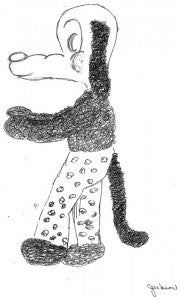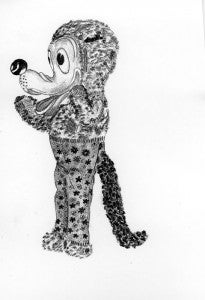Take a moment to really look at the world
Published 1:31 pm Saturday, June 11, 2011
Column: Art Is…, by Bev Jackson Cotter
Think of something that you see every day. Something that is so familiar to you that you can describe every part, in tiny detail. Now, in your mind’s eye, draw that item, including its vertical and horizontal lines, its depth, its texture, its sharpness or its roundness, its colors in both the bright and shaded areas, its personality and its spirit — yes, even an inanimate object has life.
Now evaluate your mental drawing. Does your object really look like that?
Several years ago, our assignment in a drawing class was to do what I just asked of you. My choice was a stuffed Pluto that my son had played with every day when he was a little boy. Pluto never left his side. I knew the toy dog was fuzzy with flowered pants, that he had a long snout and a round nose, that his ears were long and one of them was missing, though I couldn’t remember which one. My sketch didn’t look anything like I thought it should, but I couldn’t figure out why.
The next day, we were to bring the object to class and to draw it exactly the way we saw it. To my surprise, while I had the basic design right, the big difference was that Pluto was smiling — a big smile that made you respond in king. No wonder my son loved him so.
How often do we really see what we are looking at?
That same year, after a color design class, I drove home one day looking at the colors in the sky, hundreds of blues, each one of them giving the sky its own texture, its own brightness, and its own life. The next day, the sky looked different, it was moving, stormy, hundreds of shades of grey and blue, each bringing its own emotional response.
Most of us are very familiar with Grand Wood’s painting, “American Gothic,” the painting of a farmer and his wife standing in front of their home. Can you tell me what the color the farmer’s suit coat is, or the design in his shirt? Are his bib overalls worn or new? What color is his wife’s apron? Do you think she is his wife or daughter? What is the design on the pin at her collar? What color is the sky in the painting, or the shape of the trees, or the design of the siding on the house they are standing by, or the shape of the porch?
 I have a lacy, textured sweater that I wear often. I like its soft, foamy green color and the loosely woven fabric. But as I sit here at my computer, I cannot tell you what the buttons are like. I think they are fabric covered, but I am not sure. I know the sweater’s edges are of a different weave, but I cannot tell you exactly what they are like either. How many times have I looked at that sweater?
I have a lacy, textured sweater that I wear often. I like its soft, foamy green color and the loosely woven fabric. But as I sit here at my computer, I cannot tell you what the buttons are like. I think they are fabric covered, but I am not sure. I know the sweater’s edges are of a different weave, but I cannot tell you exactly what they are like either. How many times have I looked at that sweater?
In his book, “Drawing for Pleasure,” Peter Johnson said, “Your marks matter: they are your statement about what you perceive and feel, both outwardly and inwardly — for the world of fantasy, of course, also has its place in artistic expression.”
While he interviews artists who use many different techniques and styles, the most significant subject covered in his book is the importance of observation. The artists all talk about space, shapes, perspective, emotion, detail, movement, light, attitude and the satisfaction of drawing on location rather than in a studio. They discuss capturing the essence of their subject matter. In order to do that, they must really see and feel what they are drawing. That, perhaps, is the hardest part.
Regarding the Grant Wood painting — the farmer’s suit coat is a faded, shapeless black, his white shirt has narrow greenish stripes in sets of three, and his bib overalls are worn and discolored. His wife’s apron (because she is obviously so much younger than him, could she possibly be his daughter?) is a purplish brown with an ivory dotted pattern, and her pin is a cameo. The sky is a light blue becoming almost white on the horizon, the trees are rounded and stylized, the house’s siding is vertical board and batten, and the porch runs almost the full width of the house. Did you pass the test? I didn’t either.
My challenge to you is to take a moment from your busy life to look at our beautiful world, to really see it, and to remember.
Bev Jackson Cotter is a member of the Albert Lea Art Center where the show “Vintage Fashion & Florals” will be on display through July 30. The art center is open from 10 a.m. to 2 p.m. Tuesday through Saturday.



